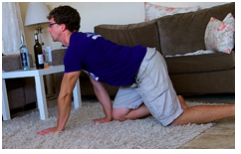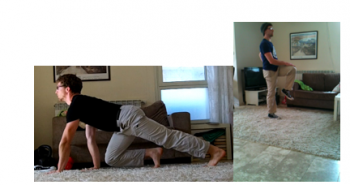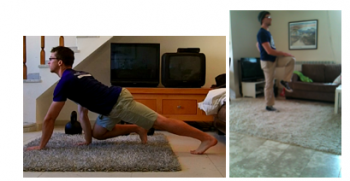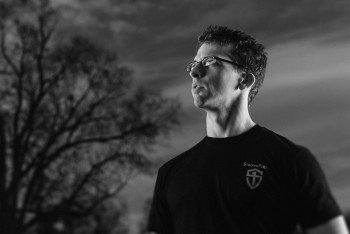Make America Gait Again!
Oct 16, 2016

And now, a guest post by Aleks Salkin, OS Level 2 instructor
[caption id="attachment_8214" align="alignright" width="261"]
 Like the title of this blog? You may also like this shirt and can buy it in the shop![/caption]
Like the title of this blog? You may also like this shirt and can buy it in the shop![/caption]Folks, our country is desperately in need of a change. We are falling apart, crumbling at our foundations, and are a downhill slide toward mediocrity and dysfunction.
We need a change that brings us back to our roots; one that unleashes the greatness we were born to express, and the raw, unbridled physicality and dominance over our surroundings.
We need to make America gait again!
Wait, what?
That’s right, gait. You know… walking. It’s the ultimate –and most unsung – movement pattern that quite literally holds the key to your lifelong health and strength. In fact, it’s one of the major things that sets us apart as human beings. So it’s kind of important.
And yet, it’s also probably the most overlooked movement in most people’s training. Why? If I had to zero in on a reason or two, I would say that it doesn’t seem “sexy” enough for most people, and it doesn’t seem tough enough. Most people would prefer to stand in place and lift weights than sharpen their walking skills. And that’s a real shame. Because while standing in place and lifting heavy can absolutely make you strong, it will make you even stronger if you’re doing so on a base of quality movement competency – namely the Original Strength resets, of which your gait reigns supreme.
Speaking of which, the Original Strength resets themselves all move us toward that very fundamental movement pattern. Consider this:
- Deep, diaphragmatic breathing helps you set the foundation of your core stability – the same stability that ultimately gets used for helping you walk and move upright.
- Neck nods begin to stimulate and activate the vestibular and proprioceptive systems (your balance system and your where-you-are-in-space system) and further help engage the muscles of the midsection and back while establishing your balance, posture, and coordination – all of which play crucial roles in your ability to walk on two feet.
- Rolling helps establish your reflexive stability (your ability to anticipate and respond to movement before it happens) within your body’s “X design”, which helps further prepare you for gait.
- Rocking helps set the S curve in your spine, which gives you the ability to walk upright, while also preparing you to crawl.
- Crawling is the foundation of your body’s contra-lateral movements and helps you build the strength and coordination to walk upright.
As the famous saying in the Good Book goes, “The writing is on the wall.” The message that we get from all the reasons is pretty clear: their benefits ultimately point us in one profoundly important direction: our gait.
But our gait is a pattern, not a singular exercise, and it can be trained in many ways to help accommodate your skill level as well as your busy schedule. Not only that, if it’s tough workouts you’re after, you can also break a sweat while learning to move better and get stronger, leaner, and fitter. So here are a few ideas – and routines – to help you start reclaiming the physical birthright that is your gait.
 Bird dog (left) dead but (right)
Bird dog (left) dead but (right)- Bird dogs and dead bugs. Do 10 bird dogs per side followed by 10 dead bugs per side. This will help you start sharpening your body’s X both on the front and back of your body. Do a few sets like this before work and (if you can manage) during and after work as well. It requires very little space – just a little room on your living room floor or maybe in an empty conference room – and will go a long way in refreshing both your body and mind from a long day of sitting.

Baby crawling. Please don’t tell me you need a picture of walking for reference.
- Baby crawl and walk. This will require a little more space, but if you’re creative you can make ample use of even as little space as is required for your dead bugs and bird dogs. Simply crawl, keeping your head up, with your knees on the ground and going forward - say, from one wall to the next – and then stand up, walk back, and repeat. Do this for 3-5 minutes and be on your way.

- Leopard crawl and march. Again, this is best done with plenty of room at your disposal, but if you’re creative you can do it even in small quarters. This is where some REAL strength and conditioning get built. Lift your knees off the ground when you crawl and make sure they track inside your elbows (and as before, keep your head up as you crawl). Go for a given distance, then stand up and march back.
 Spiderman crawling and skipping. Yes, it’s the same picture as marching. Imagine I’m skipping here.
Spiderman crawling and skipping. Yes, it’s the same picture as marching. Imagine I’m skipping here.- Spiderman crawl and skip. Much like the leopard crawl and march, only with the Spiderman crawl you’ll let your knees track outside your elbows (which will challenge you in a number of awesome ways, but will only be helpful for you IF you’re ready for it), and with skipping you’ll simply march with a bit more spring in your step. These are great for gently preparing the body for the rigors of running (which is also meant to be a reset, for the record). 5 or so minutes of alternating these two and you’ll feel bright-eyed and bushy tailed before you can say…well, whatever it is that you would want to say, I guess.
Other options that shouldn’t be overlooked include picking up a moderately heavy weight, like a kettlebell, and taking it for a walk, or crawling and dragging some weight behind you. This type of crawling, however, is a bit more advanced, so make sure you’re ready for it by putting in a lot of time with unweighted crawling first.
Lastly, don’t underestimate the power of a good, long walk done at least once a week. You’ll be amazed at what it does not only for your conditioning, but how much it will unlock your body. Case in point: this summer I spent a whole day walking around Tel Aviv and the nearby port city of Jaffa, and despite the blistering sun, several miles of walking I racked up (with a backpack on my back, no less), and serious exhaustion by the time I got back to my apartment in Jerusalem, I had a sudden urge to test out my pistol squats, and managed to do 30 in a row on my right leg and 24 in a row on my left – a PR all around.
Your gait pattern doesn’t just make you strong – it helps you unleash your strength in a variety of other fields, including your favorite pet lifts and exercises. If you’re spending a lot of time sitting – or lifting – in one place, try adding some gait pattern work to your training and watch as the results roll in. A little done daily will take you a long way.
Go forth, train your gait, and be great!
 Aleks Salkin is a level 2 StrongFirst-certified kettlebell instructor (SFG II) and an Original Strength Instructor. He grew up scrawny, unathletic, weak, and goofy until he was exposed to kettlebells and the teachings and methodology of Pavel in his early 20s. He is currently based out of Jerusalem, Israel and spends his time teaching clients both in person and online as well as spreading the word of StrongFirst and calisthenics. He is the author of The 8-Week Kettlebell and Bodyweight Challenge (https://alekssalkin.leadpages.co/8weekchallenge/ ). Find him online at https://www.alekssalkin.com and on Facebook at https://www.facebook.com/alekssalkintraining
Aleks Salkin is a level 2 StrongFirst-certified kettlebell instructor (SFG II) and an Original Strength Instructor. He grew up scrawny, unathletic, weak, and goofy until he was exposed to kettlebells and the teachings and methodology of Pavel in his early 20s. He is currently based out of Jerusalem, Israel and spends his time teaching clients both in person and online as well as spreading the word of StrongFirst and calisthenics. He is the author of The 8-Week Kettlebell and Bodyweight Challenge (https://alekssalkin.leadpages.co/8weekchallenge/ ). Find him online at https://www.alekssalkin.com and on Facebook at https://www.facebook.com/alekssalkintraining
Comments (0)
Please login to comment.